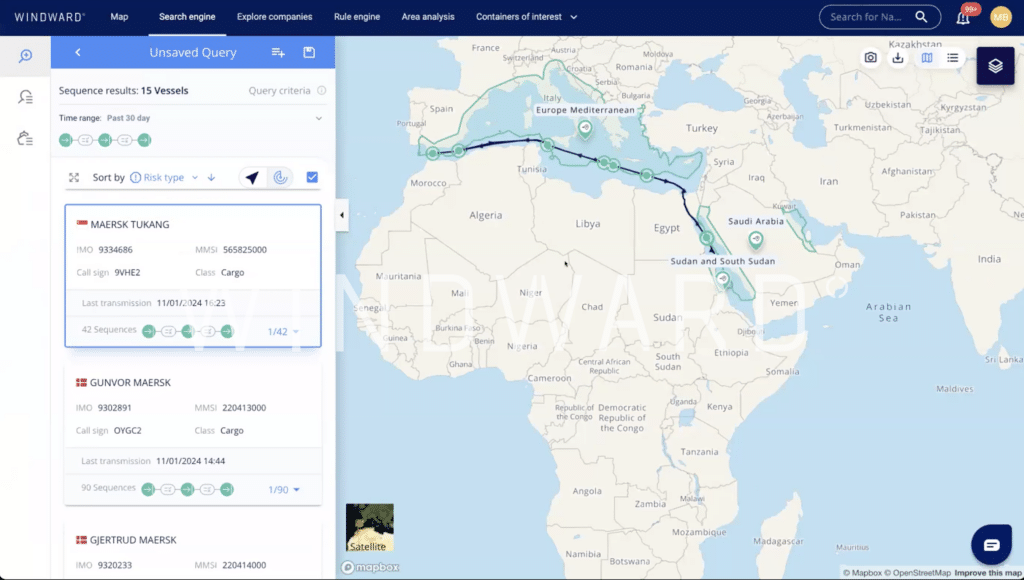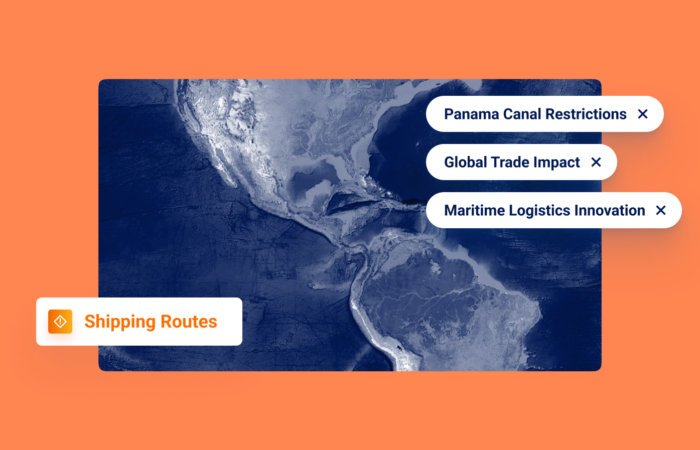What’s inside?
Windward’s recent webinar on the Red Sea crisis was our most popular one yet. Host Ami Daniel, Windward’s Co-Founder and CEO, kept it interactive and made sure that the top industry experts who were participating shared their actionable insights and answered as many of the questions that popped up as possible. Those experts included:
- Peter Sand, Chief Analyst, Xeneta
- Joshua Hutchinson, Managing Director Intelligence & Risk, Ambrey
- Jakob P. Larsen, Head of Maritime Security and Safety, BIMCO
Let’s look at some of those questions and answers, helping you better navigate what has become a pivotal concern in global maritime and supply chain operations.
Dark Activities by Container Vessels
Question: Is it safer to turn off a vessel’s AIS to avoid Houthi attacks?
Joshua Hutchinson from Ambrey noted that some vessels that turned their AIS off early on in the conflict were still targeted. There are several ways to track a vessel that are still publicly available. Turning off the AIS doesn’t mean a vessel is completely hidden. We’ve also seen an escalation in the past couple of weeks where we see spotters on the water. UAVs are being used to recon targets before impact, that has been well-recorded in the area.”
What is BIMCO’s recommendation? Jakob P. Larsen explained that the decision depends on each company and their risk assessment. The reality is that BIMCO can’t and won’t give specific recommendations, but rather outlines what is going on and how these factors interact, and then each organization can make its own decision, depending on its risk appetite.

Vessel Movement Patterns and the Suez Canal
Question: Do you notice a pattern of vessels crossing the Suez Canal and turning back to Europe?
The Windward Maritime AI™ platform’s new Sequence Search capability enables users to track vessels’ sequence of activities. During the webinar, Mattan Benyamini, Product Manager at Windward, used this new technology to report that 15 large cargo container vessels had visited the Mediterranean Sea, passed through the Suez Canal, and then returned to Europe within the last month. This pattern underlines the significant impact of the crisis on the global supply chain. During this ongoing crisis, technology can be and should be used to stay on top of changes.

Congestion and First-Time Crossings at the Cape of Good Hope
Question: If 70% of vessels start calling the Cape of Good Hope, there could be huge amounts of congestion…how will the industry mitigate this? What is the current waiting period for clean tanker vessels at the Cape of Good Hope?
Real-time analysis using Windward’s system showed that at least 18 vessels crossed the Cape of Good Hope for the first time in the past month, indicating a shift in maritime traffic patterns due to the crisis. This change was identified via an algorithm in Windward’s Maritime AI™ platform that detects a vessel’s first visit to a specific area. As explained by Ami, more vessels are traveling to the Cape of Good Hope than ever before. Mattan also pointed out that in the last month, there has been a significant increase in port calls at the Durban Port in South Africa. It is becoming more congested, with an increase in vessels bunkering there.
Blank Sailings in North China
Question: Are carriers blanking North China to make better time?
In answering this question, Peter Sand, emphasized the importance of close market monitoring to analyze options and act swiftly in such rapidly evolving situations. Despite the lack of widespread announcements about blank sailings, real-time market monitoring showed that such actions were indeed occurring. This insight underlines the necessity for stakeholders to stay informed and agile to navigate these turbulent times effectively.
Freight Rates
There is justifiably a lot of talk about rising freight rates and what to do about them in the industry at the moment. During the webinar, Peter observed that the rates people are complaining about today will likely look good in a few more days. Also, he explained why organizations might not want to negotiate the lowest price they can get…
Organizations trying to move cargo out of Asia and into the Mediterranean, North Europe, or U.S. East Coast, may not only target market average (freight rates) for their next contract. They may actually go for what is currently mid-high in the market. Because next week, that will likely be the market average. And if they want their cargo to move, they won’t want to be paying the lowest rate, because carriers may find it attractive to leave that cargo to move to more expensive freight…
Navigating Through Turbulence with Data and AI
The Red Sea crisis shows us how a fluid, high-stakes situation can impact all stakeholders in the maritime and supply chain industries. Data analysis and AI play a critical role in understanding and responding to dynamic global trade conditions, especially when there is a critical need for all stakeholders to be well-informed and adaptable in the face of uncertainty.
There were so many great questions in the webinar, we recommend watching it to hear all of the interesting answers and perspectives for yourselves. Have any more questions? Feel free to reach out below.







